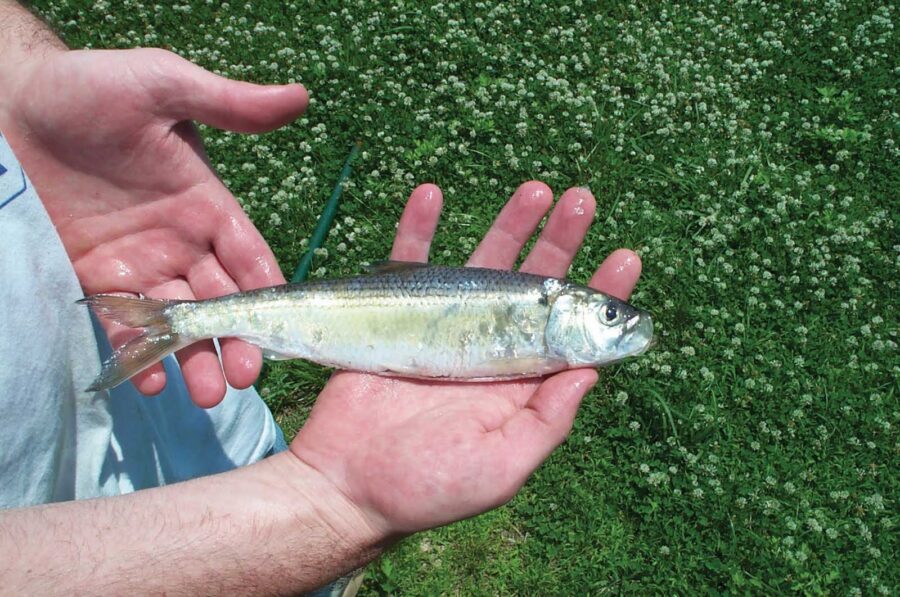Ecosystem Targets and Supporting Indicators
Shad & River Herring—Long Island Sound
Abundance of American shad and river herring, as reported in the Long Island Sound Trawl Survey.
View Implementation Actions for Shad & River Herring—Long Island Sound| Shad & River Herring - Long Island Sound (count per tow) | ||
|---|---|---|
| River Herring | American Shad | |
| 1984 | 1.96 | 3.13 |
| 1985 | 0.25 | 0.19 |
| 1986 | 0.58 | 0.27 |
| 1987 | 0.66 | 0.29 |
| 1988 | 0.58 | 2.66 |
| 1989 | 0.67 | 3.10 |
| 1990 | 0.43 | 0.65 |
| 1991 | 0.32 | 0.72 |
| 1992 | 0.44 | 0.54 |
| 1993 | 0.67 | 1.11 |
| 1994 | 2.04 | 1.84 |
| 1995 | 0.81 | 1.90 |
| 1996 | 1.33 | 0.27 |
| 1997 | 1.83 | 0.91 |
| 1998 | 0.82 | 1.22 |
| 1999 | 1.21 | 1.73 |
| 2000 | 1.01 | 0.55 |
| 2001 | 0.80 | 0.41 |
| 2002 | 0.70 | 0.76 |
| 2003 | 1.11 | 0.75 |
| 2004 | 1.18 | 0.95 |
| 2005 | 1.04 | 0.54 |
| 2006 | 0.59 | 0.12 |
| 2007 | 1.45 | 0.38 |
| 2008 | 1.15 | 0.41 |
| 2009 | 0.81 | 0.46 |
| 2010 | 1.68 | - |
| 2011 | 0.76 | 0.42 |
| 2012 | 0.47 | 0.44 |
| 2013 | 0.85 | 0.31 |
| 2014 | 0.62 | 0.20 |
| 2015 | 1.01 | 0.71 |
| 2016 | 1.05 | 0.85 |
| 2017 | 0.21 | 0.63 |
| 2018 | 0.72 | 0.80 |
| 2019 | 1.08 | 1.43 |
| 2020 | Null | Null |
| 2021 | 0.32 | 1.36 |
| 2022 | 0.49 | 0.42 |
| 2023 | 0.29 | 0.63 |
WHAT ARE SHAD AND River HERRING?
River herring is a collective term for the alewife, Alosa pseudoharengus, and blueback herring, Alosa aestivalis, two anadromous fish species that are related to the American shad. Anadromous fish migrate from the ocean to rivers to spawn. The coastal range of the alewife extends from northeastern Newfoundland to South Carolina, while that of the blueback herring extends from Nova Scotia to Florida. Both species undertake upriver spawning migrations during spring. The American shad, Alosa sapidissima, is the largest of the herring family, and is a favorite Connecticut River sportfish. It also undertakes upriver spawning migration during spring. The historic range of American shad was from the St. Lawrence River to Florida. Shad are still distributed throughout their historic range but shad are most abundant in east coast rivers between Connecticut and North Carolina.
WHAT DOES THIS INDICATE?
River herring and shad are important to our freshwater, marine and estuarine ecosystems because adult herring and their young provide food for a variety of predators including freshwater gamefish, marine gamefish, osprey, bald eagle, harbor seals, porpoise, egrets, kingfishers, and river otter. Shad supported an extremely important fishery from CT’s earliest history. Indigenous peoples living near shad runs and the earliest colonists relied on the spring shad migrations for food, setting multiple fixed nets on the riverbanks. The commercial fishery is now reduced to only a small remnant of folks, mostly representatives of the fishing families who used to make a living fishing the lower CT River with drift gill nets.
STATUS
American shad migrate from the ocean to rivers to spawn. Their year-to-year populations vary, often depending on differences in recruitment of individual year classes. According to the 2021 American Shad Habitat Plan for Connecticut, Connecticut has an approved Sustainability Fishing Management Plan (SFMP) to allow recreational and commercial fisheries for shad in the Connecticut River – one of the largest and most stable American Shad runs on the East Coast. However, shad harvest is prohibited in Connecticut’s other rivers until the populations grow to the level where a SFMP could be considered.
River herring (blueback herring and alewife) have declined dramatically in recent years. Predation from striped bass and other species may be a factor in declining populations for both species. In Connecticut waters a moratorium on the taking of river herring remains in place since 2001.
DATA NOTES
- The American Shad data is from CT DEEP’s fall trawl survey, while the River Herring is an annual index (including CT DEEP’s spring and fall trawl surveys). The survey uses geometric mean instead of arithmetic mean to find the most frequently observed number of fish collected per tow. In a natural environment such as Long Island Sound fish have a “patchy” distribution, i.e. some areas will have a very high abundance of fish, and other areas very low abundance or no fish at all. An arithmetic mean can be easily biased by unusually high or low values so that it doesn’t reflect the true center of a data set. The geometric mean minimizes the effects of very high or low values using a log transformation and is a better average for this type of biological data.
- In fall 2010, sampling was cancelled because the CT DEEP’s research vessel was out of service due to repairs.
- In 2020, CT DEEP was unable to conduct its Long Island Sound Trawl Survey due to COVID-19 restrictions.

